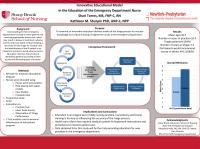Team Triage
View File(s)
Visitor Statistics
Visits vs Downloads
Visitors - World Map
Top Visiting Countries
| Country | Visits |
|---|
Top Visiting Cities
| City | Visits |
|---|
Visits (last 6 months)
Downloads (last 6 months)
Popular Works for Miller, Michelle by View
| Title | Page Views |
|---|
Popular Works for Miller, Michelle by Download
| Title | Downloads |
|---|
View Citations
Citations
The citations below are meant to be used as guidelines. Patrons must make any necessary corrections before using. Pay special attention to personal names, capitalization, and dates. Always consult appropriate citation style resources for the exact formatting and punctuation guidelines.
Item Information
Item Link - Use this link for citations and online mentions.
Abstract
Purpose: The Institute of Medicine declared Emergency department (ED) overcrowding as a national crisis. Throughput is a concept used to understand ED overcrowding and is defined as the time measured between a patient’s arrival in the ED to disposition (i.e. discharge or admission). When EDs are overcrowded and throughput is poor, patient safety is compromised, timeliness to appropriate treatment is delayed, and ultimately patient satisfaction plummets. Improving throughput is essential to patient satisfaction, patient outcomes, and the overall hospital process. “Team Triage” (TT), or the introduction of an advanced provider in triage to initiate a treatment plan from triage, is one method to improve throughput. The purpose of this project is to evaluate the influence of “TT” on throughput metrics including length of stay (LOS), left without being seen rates (LWBS), and time to provider (TTP) at the University of Illinois’ Hospital (UIH) ED. Design: Quality improvement project. Setting: A teaching, urban, level II trauma center. Participants/Subjects: All ED staff participated in this project. Methods: “TT” at UIH introduces an APN’s participation to the triage process. The APN initiates a plan of care based on the patient’s medical history, vital signs, and chief complaint at triage. A tech and RN facilitate the “TT” process through executing the treatment plan initiated by the APN. LWBS, LOS, and TTP rates are measured each month after “TT” is introduced to UIH ED. Results/Outcomes: “TT” is a promising method to improve throughput metrics of LWBS, LOS, and TTP. Metrics from July 2016 to June 2017 for LWBS, LOS, and TTP are: 4.5% and 2.6%, 327 minutes to 315 minutes, and 32 minutes and 38 minutes, respectively. UIH will continue to collect, evaluate, and disseminate data to monitor the impact of “TT” on ED metrics. Implications: Introducing an advanced practitioner to the triage process has proven to improve throughput metrics at UIH. Initiating a plan of care from triage can improve patient and staff satisfaction by reducing LOS, improving turn around time for imaging and lab work, and ensuring each patient is seen by an APN within minutes of registering to the ED. Recommendations for researchers is to review the Team Triage impact on Press Ganey scores and the financial impact.
Description
Emergency Nursing 2018. Held at David L. Lawrence Convention Center, Pittsburgh, Pennsylvania, USA
Repository Posting Date
2019-01-18T17:29:10Z
Type Information
| Type | Poster |
| Acquisition | Proxy-submission |
| Review Type | Abstract Review Only: Reviewed by Event Host |
| Format | Text-based Document |
Category Information
| Evidence Level | N/A |
| Research Approach | N/A |
| Keywords | Team Triage; Advanced Provider in Triage; Emergency Department Overcrowding |
Conference Information
| Name | Emergency Nursing 2018 |
| Host | Emergency Nurses Association |
| Location | Pittsburgh, Pennsylvania, USA |
| Date | 2018 |
Rights Holder
All rights reserved by the author(s) and/or publisher(s) listed in this item record unless relinquished in whole or part by a rights notation or a Creative Commons License present in this item record.
All permission requests should be directed accordingly and not to the Sigma Repository.
All submitting authors or publishers have affirmed that when using material in their work where they do not own copyright, they have obtained permission of the copyright holder prior to submission and the rights holder has been acknowledged as necessary.
Related items
Showing items related by title, author, creator and subjects.
-
What is the effect on knowledge, staff satisfaction and competency of care after educating providers on emergency department triage in an urban academic medical center?
Torres, Shari (2016-03-17)Session presented on Saturday, July 25, 2015: Background. Hospitals in recent years have shown an increase in overcrowding in their emergency departments due to hospital closures, lack of primary care and an aging population. ... -
Quality improvement project for door-to-EKG time for emergency room
Dorrough, JodiThe American Heart Association recommends the initiation of an EKG with interpretation in less than 10 minutes upon presentation to the emergency room for patients presenting with acute coronary symptoms. Treatment delay ... -
Trauma RN EJ Program: Advancing nursing practice and reducing IV team activations in the emergency department
Khoshnevis, BrandeePurpose: PIV access in the ED can be challenging. Failed attempts often prompt RNs to place an order for Vascular Access Team (VAT). This delays patient care by prolonging the time from MD to order to obtaining labs & ... -
The role of fast tracks on length of stay in emergency departments
Watson, Brandon; Borkowski, Konrad; Conca-Petit, Jonathan (5/18/2017)Overcrowding in emergency departments (EDs) is a national crisis affecting hospitals. It has led to an association with poor patient outcomes and is a threat to public safety. Fast tracks (FTs) in the ED are one strategy ... -
Perspectives of emergency nurses with overcrowding state in Taiwan
Lin, Chun-Chih; Chen, Li-Chin; Han, Chin-Yen; Wu, Chiung-Jung (Jo) (2017-07-27)A symbolic interactionism was used to explore emergency nurses’ perspectives on their working role in the overcrowding state. Main themes of seeking and keeping within boundaries were identified.





